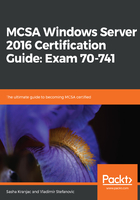
Configuring IPv6 addressing
Initially, the address space of 4,294,967,296 possible addresses (232) seemed inexhaustible and the address space was generously segmented and assigned. Back then, such thinking seemed reasonable because nobody expected the exponential growth of the internet or such a large number of connected devices. Nowadays, we are facing the depletion of the IPv4 address space, which was predicted years ago. The need for a solution to this problem led to development of the sixth generation of the IP protocol – IPv6. The IPv4 address is 32 bits long, while IPv6 uses 128-bit long addresses. Compared to IPv4, IPv6 has a four times larger address space of 2128, or 340,282,366,920,938,463,463,374,607,431,768,211,456 addresses. This is significantly more than IPv4; however, IPv6 was not designed solely with host addressing in mind, but also to be able to accommodate newer 64-bit macOS addresses.